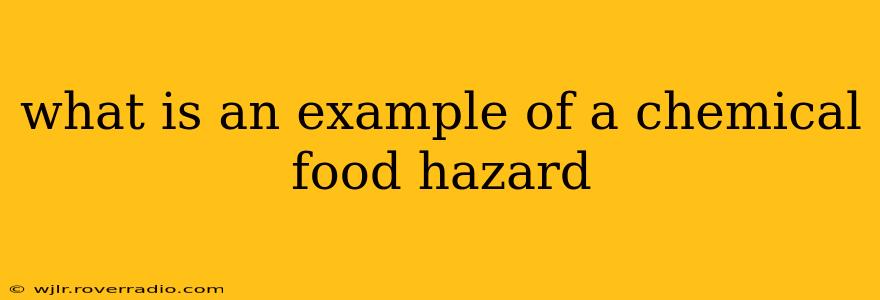What is an Example of a Chemical Food Hazard?
Chemical food hazards are substances that contaminate food and can cause illness or injury when ingested. They're a significant concern in food safety, impacting everything from production to consumption. Unlike biological hazards (like bacteria) or physical hazards (like glass shards), chemical hazards originate from a variety of sources, both intentional and unintentional.
Let's explore some key examples and delve into what makes them dangerous:
What are some common chemical food hazards?
This is a broad question, as numerous chemicals can contaminate food. Some prominent examples include:
-
Pesticides: These are intentionally applied to crops to control pests, but residues can remain on produce if not properly washed or if excessive amounts are used. Organophosphates and carbamates are examples of pesticide classes that can pose significant health risks if ingested in high enough quantities. Symptoms can range from mild gastrointestinal upset to neurological effects.
-
Cleaning agents and sanitizers: Accidental contamination can occur if cleaning chemicals are not properly rinsed from food contact surfaces. These chemicals can cause anything from irritation to severe poisoning, depending on the specific agent and the level of exposure.
-
Heavy metals: These naturally occurring elements like lead, mercury, and cadmium can contaminate food through various pathways, including soil, water, and air pollution. Accumulation of heavy metals in the body can lead to serious health problems, including neurological damage and kidney failure. This often stems from contaminated water sources or industrial pollution impacting agricultural lands.
-
Industrial chemicals: Accidental contamination can occur if food products are stored near or come into contact with industrial chemicals. This is particularly relevant in areas with inadequate regulation or accidental spills. The specific health effects depend greatly on the chemical involved.
-
Naturally occurring toxins: Certain plants and fungi contain naturally occurring toxins that can cause illness if ingested. Examples include aflatoxins (produced by certain molds on grains and nuts), and solanine (found in potatoes exposed to light).
-
Food additives: While generally safe at approved levels, excessive amounts or the presence of unapproved food additives can cause health problems. It's crucial to follow regulatory guidelines for the safe use of food additives.
What are the symptoms of chemical food poisoning?
Symptoms of chemical food poisoning are highly variable and depend entirely on the specific chemical involved and the level of exposure. They can range from mild symptoms like nausea, vomiting, and diarrhea to more severe effects like organ damage, neurological problems, or even death. Some chemicals may cause delayed reactions, making it difficult to directly link the symptoms to the contaminated food.
How can I avoid chemical food hazards?
Minimizing your risk of exposure to chemical food hazards involves a multi-pronged approach:
-
Thorough washing of produce: Washing fruits and vegetables thoroughly under running water can help remove pesticide residues.
-
Proper food storage: Storing food properly, away from cleaning agents and other chemicals, is crucial.
-
Careful selection of food sources: Choose reputable suppliers who adhere to strict food safety standards.
-
Paying attention to food recalls: Stay informed about food recalls issued by regulatory agencies.
-
Following food preparation guidelines: Adhere to safe food handling and preparation practices to minimize the risk of contamination.
By understanding the different sources of chemical food hazards and taking proactive steps to mitigate risks, we can significantly improve food safety and protect our health. Remember to always consult with a medical professional if you suspect you have experienced chemical food poisoning.
